What Does “Local SEO” Mean These Days?
Local SEO can mean a lot of things. For the sake of this article, it refers to organic visibility in Google Maps via the Local Pack. Or, more plainly, your Google Business Profile (GBP).
GBP is particularly relevant today because small businesses are losing organic clicks from top and mid-funnel queries to AI Overviews (AIO). For any business or marketer, fewer clicks means less data. For these small businesses, it can mean fewer leads, too.
In other words, showing up for bottom-of-funnel search queries is more important than ever. For local businesses, those queries are the ones driving prospective customers to the Local Pack.
How AIOs Impact SMBs: A Quick Look at 2025
For a lot of businesses, clicks go down as AIOs take over relevant search engine results pages (SERPs). This is true even if the business ranks well in the overviews, as the business referenced below does. While some AIO citations result in clicks, many do not.

Correlation is not causation, but this is not an isolated example. SMBs are seeing fewer clicks across the board, and it’s not difficult to guess why.
GBP is a Critical Source of Leads for SMBs
The bright side is this: GBP remains a critical source of leads for SMBs. In fact, I’ve seen about 10-15% more calls come through GBP compared to pre-AIO times.
Additionally, first-time calls to businesses with aggressive marketing packages saw their Google listings start to drive more leads than their organic website traffic (which was unusual for the businesses I work with, historically).
With the advent of AIOs, GBP has overtaken organic search for phone calls by a margin of about 12%.
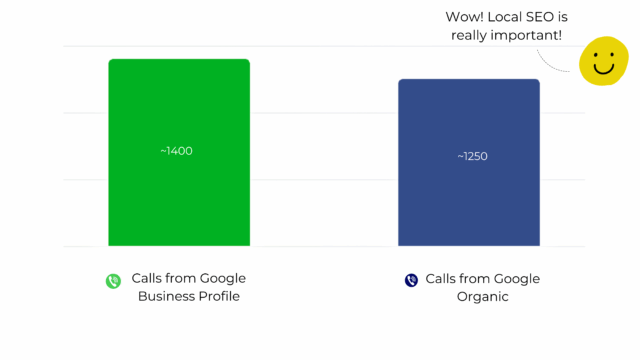
Note: This data is taken from a 3-month period after AIOs rolled out in this given client set’s industry, compared to the previous period, and cross-referenced against the previous year.
Small Business Local SEO 101: Make Patterns, Not Big Changes
SMBs need an actionable and consistent approach to GBP. We’ll dive into tactics in a minute, but for now, I want to focus on the right approach: Don’t look for one “big” change to fix everything. Look for small improvements and iterate on them.
Google actually encourages this approach with on-site SEO in its SEO Starter guide. It says “…if you’re not satisfied with your results and your business strategies allow it, try iterating with the changes and see if they make a difference.”
This statement isn’t about GBP, but the same principle applies. Don’t chase the big fixes; instead, iterate on the small ones to create a positive pattern.
This includes things like:
- Posting regularly, in a natural cadence that reflects your business’s updates, events, specials, etc.
- Gathering reviews over time, naturally, and in a way that reflects customer experience
- Consistently reviewing changes to your GBP data and keeping it fresh, accurate, and updated
- Responding to reviews consistently, over time
- Responding to customer questions in the Q&A section as they are asked
- Keeping your website updated with relevant content and information
Try our Free Local Lead Conversion Checklist
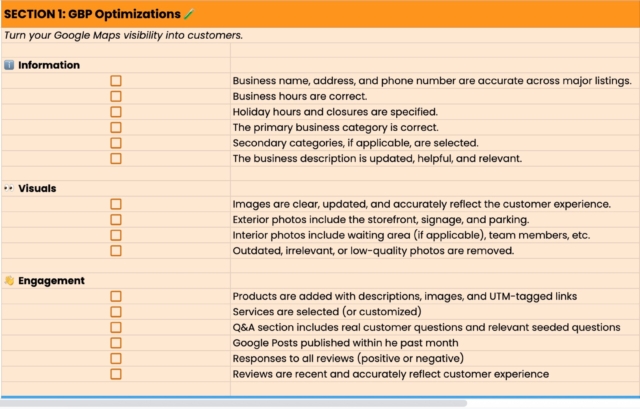
Make sure every local lead counts. This checklist walks you through key steps to turn Google Business Profile visibility into real customer conversions.
Let’s Talk Strategy: Tactics that Customers (and Google!) Love
So, what patterns should you create? And which tactics create them? The simple answer is this: Focus on the things you can control, or at least try to.
Below, I’ve listed what I consider the more important local SEO tactics for small businesses. Some of them may seem obvious; others not. But they’re all important, especially when taken as part of a larger strategy.
Keep Your Profile Updated & Accurate
This one’s pretty obvious: it’s important to keep your business information updated and accurate. Not because it’ll help you rank, but because it’s a good customer experience. (And because customers will get annoyed if your information is wrong.)
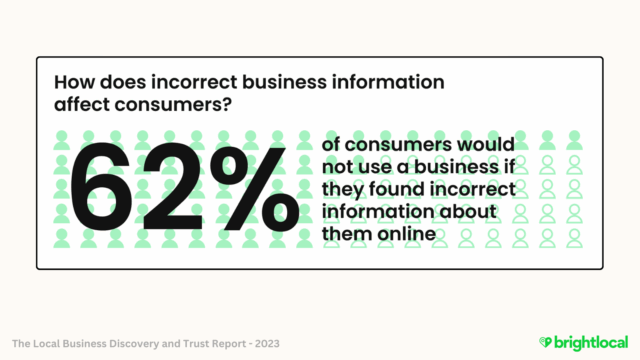
A 2023 study from BrightLocal found that 62% of consumers would not use a business if they found incorrect information about them online.
It’s also completely within your control and could impact whether or not a customer is able to find or call you. Thus, it’s worth noting.
Describe Your Business Accurately (Don’t worry about the SEO)
As a general rule of thumb, make sure your GBP accurately reflects your business as customers experience it in the real world. This means filling out every field in your profile and adding as much detail as GBP allows, including your business description.
Here are a few best practices for the description:
- DO fill out your business description with as much helpful information as possible, so customers can see what you’re about.
- DON’T use keywords in your description or try to cater to what you think Google wants.
Keep Your Photos Updated (and Helpful)
Include photos of your business storefront so customers know what it looks like from the street or parking lot. Add pictures of the inside, too, so they know what to expect when they get there.
Update images if something changes. This is especially relevant for businesses (such as restaurants) that change their menu frequently. Service-based businesses, such as law firms, may not need to update their photos as often unless something at the business location changes.
A few things to avoid:
- Stock photos
- Geo-tagging your images
- Low-quality images
- Outdated images
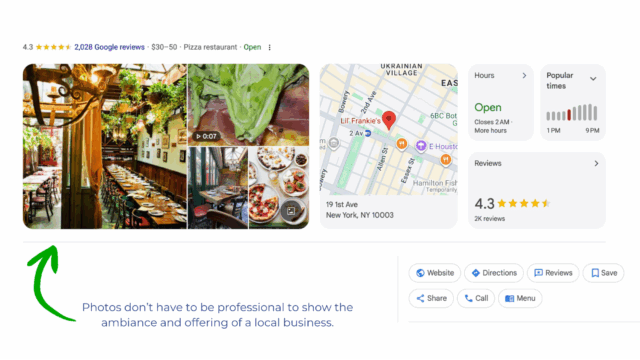
Remember: You don’t need a professional photoshoot to give customers an idea of what your business is about. And for some business types, customer photos will do just fine!
Show Customers What You Have to Offer
If it’s available for your business type, add products and services to your listing.
Products are detailed snapshots of what you offer; services are more like a menu of what you do.
I find the products feature particularly valuable because you can add a detailed description, image, and link to a related page on your website from the product listing. Even for service-based businesses (like law firms or dentists), “products” are a great way to give customers more information about how you can help them.
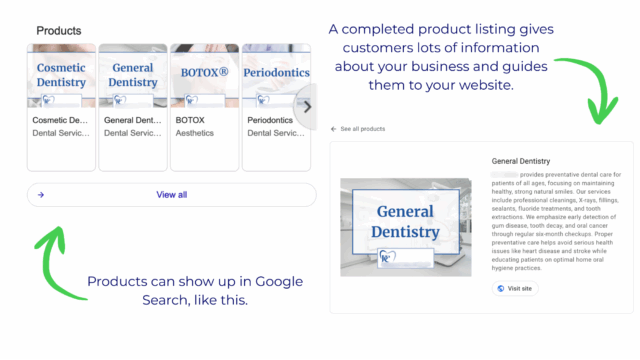
Prep for GBP Suspensions Before They Happen
Google Business Profile suspensions are a hassle. Prepare for them in advance. There are two types of suspensions: hard and soft suspensions. A soft suspension keeps you from editing your business information; a hard suspension completely removes it from SERPs.
If your listing gets suspended, you can appeal it and submit evidence for reinstatement.
Here’s a quick list of what you should have on file to make sure you can appeal your listing quickly in the unfortunate event of a suspension:
- Business registration
- Business license
- Tax certificates
- Utility bills (Internet, phone, water, etc.)
I also recommend keeping a picture of their storefront with signage on hand as well.
Note: Some documents, like tax information, may contain sensitive information. You can redact personal information and still demonstrate that the business is legitimate. I’ve done this for clients in the past, and the appeal has gone through just fine. The key is to make sure the business name and address match the documentation that you submit in the event of a suspension and an appeal.
Reviews, Reviews, Reviews
Treat reviews like an ongoing part of your business operations and request them consistently.
The number of reviews and average star rating are important, but velocity (how often people review your business) is also important. If you can, I recommend using review management software, such as BrightLocal, GatherUp, or Podium, to request reviews.
A few best practices and notes regarding reviews:
- It’s okay if your star rating isn’t 5/5. People know you’re not perfect, and a 4.8/5 can look more authentic to customers anyway.
- Respond to reviews. Be kind and don’t get defensive. If you’re able, offer to fix the problem. If not, let the customer know you’ll do better next time.
- If a review is fake or harassment, do not respond to it; instead, report it to Google so it can be removed.
- Do not have your employees leave reviews! Only reviews from real customers count.
Perfect Your Intake (Make Every Lead Count)
It’s easy to treat your digital marketing as something separate from your business’s day-to-day operations. Once you get a lead or someone walks through the door, your Google Listing has done its job, right?
Kind of. The next step is just as important, though. When you get a lead (call, form, text), you need to make sure that prospective customers have the same helpful experience they got online. If you can, audit your intake (you’ll need call tracking for this!) and coach your team on how to work with prospective customers/clients when they reach out.
The goal is to turn leads into revenue, and that only happens when the lead converts.
Track everything really well (call Tracking, UTM codes, etc.)
Speaking of call tracking, if your business gets leads over the phone, use call tracking software on your website and your Google listing. Call data is part of your local SEO Strategy.
Set up call recording (if permitted by local laws) and pay attention to the origin of your calls.
Additionally, make sure to add UTM tracking codes to your Google listing and any links on it (appointment link, product link, website link, etc.). I won’t go into too much detail here, but this resource from Claire Carlile has everything you need to know (including a template!).
What about directory listings (other than GBP)?
“Local SEO” used to be synonymous with “directory listings,” and the general rule of thumb was this: The more, the merrier! Today, it’s more closely associated with Google Maps optimization, and it’s worth asking whether other directories are worth the time and money it takes to stay listed in them.
Not long ago, I revised my approach to these third-party listings and removed clients from many of them. Here’s what happened:
- Rankings did not go down (they went up, on average, for important terms)
- Leads did not go down (they went up, on average, for most clients)
This doesn’t mean directories don’t have their place, but syndicating your business information to 80+ listings that will never be indexed or seen by humans simply is not needed to achieve local SEO success.
My advice is this: Be judicious about what listings you put your business in, and focus on the ones you know will bring value. Google, Yelp, and Bing are the first three you’ll want to focus on. Some industries (legal and medical, for instance) may have niche, industry-specific listings that are still relevant (Findlaw, Zocdoc, etc.)
A good way to check if a niche listing is relevant is to do a few searches for keywords your customers might look for (local ones) and see if those directories show up on the first page of SERPs.
Those are the listings that matter.
Finally, unless you are doing your directory management manually, I recommend working with a provider who knows SEO and understands the value of listings. I prefer BrightLocal’s Citation Builder, but there are a few solid options out there to choose from, so do a little research and see what suits your needs.
When Third-party Directory Listings Really Matter
Local SEO is still SEO, so “it depends” applies even to third-party directory listings. There are a few technical instances in which directories are relevant, and not just for your ideal clients:
New Businesses
I’ve worked with some new businesses that struggle to get their Google listing verified because they are so new.
If your business falls into this category, consider getting it listed in more directories than I recommended above. Listings that come with a unique profile that Google can index are best. Syndicating your data to many publishers is one way you can show search engines that your business is, in fact, “legit” and has some semblance of an online footprint.
Website Indexation
The same goes for new websites (often associated with new businesses).
In recent years, I’ve seen new domains struggle to get indexed without the help of some third-party mentions. Directory listings are one way to encourage crawlers to engage with your site.
Of course, your website needs to include some kind of value and helpful content, too, but getting onto directory listings can help move the indexation process along.
Address Changes
Changing an address in GBP can be really easy, but it can also be tough if Google deems the change unreliable. Having additional listings (ones that are easier to update, ideally) with the new address in place can increase the likelihood of Google accepting the change quickly.
Your On-site SEO Matters, Too!
Your website is part of your local SEO strategy, too. Not only because it can rank for local queries, but also because your website optimization can impact your performance in Google Maps.
It goes without saying that for your GBP to reap the benefits of an optimized and authoritative website, you need a live website to optimize. But research shows that only 40% of SMBs said they had a dedicated website for their business.
Here’s an example of how an active website can impact your local SEO:
I encountered a business not too long ago that wasn’t new, wasn’t indexed except for the home page. Additionally, Google refused to display their website on GBP (would deny the update every time). Initially, the clear problem was thin content. However, the site encountered the same issues after that was fixed.
After checking the site’s technical elements (robots.txt, internal links, etc.), I noticed unsavory backlinks in the client’s backlink profile and submitted a disavow file.
Within two weeks, the site was indexed, and the firm’s visibility in Google Maps increased by 44%. Calls followed a similar pattern:

In short, the relevance of your website impacts the relevance of your Google listing.
If you’re interested in how to structure your website for local success and how to optimize your service pages, check out my course on mastering service page optimization from BrightLocal Academy.
Conclusion
SEO is iterative, and local SEO is no exception. Don’t look for one big lever you can pull and walk away. GBP isn’t a slot machine. If you treat it like one, you’ll end up disappointed. Look for the little things you can do consistently (and well!) that pile up over time. That’s how you win.


